Djiboutian franc
The Djiboutian franc (Arabic: فرنك) is the currency of Djibouti. Its ISO 4217 currency code is DJF. Historically, it was subdivided into 100 centimes.
| Djiboutian franc | |
|---|---|
| franc djibouti (in French)الفرنك الجيبوتي (in Arabic) | |
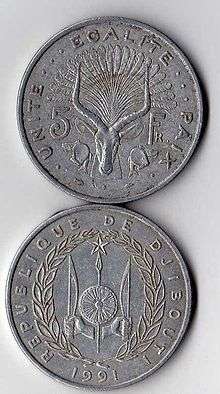 5 Djiboutian francs, minted in 1991. | |
| ISO 4217 | |
| Code | DJF |
| Denominations | |
| Subunit | |
| 1/100 | centime |
| Symbol | Fdj |
| Banknotes | 40 (commemorative), 1000, 2000, 5000, 10,000 Fdj |
| Coins | 1, 2, 5, 10, 20, 50, 100, 250, 500 Fdj |
| Demographics | |
| User(s) | |
| Issuance | |
| Central bank | Central Bank of Djibouti |
| Website | www |
| Valuation | |
| Inflation | 2.1% (2015 est.) |
| Source | The World Factbook, 2013 est. |
| Pegged with | U.S. dollar = 177.721 francs |
History
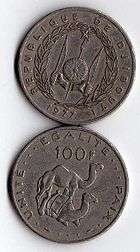
From 1884, when the French Somaliland protectorate was established, the French franc circulated alongside the Indian rupee and the Maria Theresa thaler. These coexisted with 2 francs = 1 rupee and 4.2 francs = 1 Maria Theresa thaler.
From 1908, francs circulating in Djibouti were legally fixed at the value of the French franc. Starting in 1910, banknotes were issued for the then colony by the Bank of Indochina. Chamber of Commerce paper money and tokens were issued between 1919 and 1922.
In 1948, the first coins were issued specifically for use in Djibouti, in the name of the "Côte Française des Somalis". In 1949, an independent Djiboutian franc came into being when the local currency was pegged to the US dollar at a rate of 214.392 francs = 1 dollar. This was the value which the French franc had under the Bretton Woods system until a few months before. Consequently, the Djiboutian economy was not affected by the further devaluations of the French franc.
In 1952, the Public Treasury took over the production of paper money. French Somaliland's change of name in 1967 to the French Territory of the Afars and the Issas was reflected on both the territory's coins and notes. In 1971 and 1973, the franc was revalued against the US dollar, first to a rate of 197.466 to the dollar, then 177.721, a rate which has been maintained ever since. A further change in coin and banknote design followed independence in 1977.
Coins
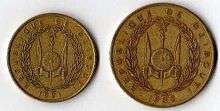
Between 1920 and 1922, the Chamber of Commerce issued tokens struck in zinc, aluminium, bronze and aluminium-bronze in denominations of 5, 10, 25 and 50 centimes and 1 franc. Shapes included round, hexagonal and octagonal.
In 1948, aluminium 1, 2 and 5 francs were introduced. Aluminium-bronze 20 francs were introduced in 1952, followed by 10 francs in 1965. Cupro-nickel 50 and 100 francs were introduced in 1970, with aluminium-bronze 500 francs added in 1989.
From 2013, new coins of 250 francs were put in circulation to complement the other denominations.
| Obverse | Reverse | Value | Obverse | Reverse | Date of issue |
|---|---|---|---|---|---|
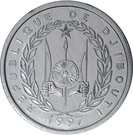 |
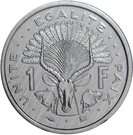 |
1 Franc | Coat of arms of Djibouti | Head of waterbuck ; value | 1997 |
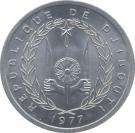 |
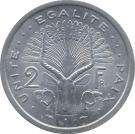 |
2 Francs | Coat of arms of Djibouti | Head of waterbuck ; value | 1977 |
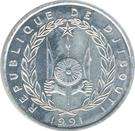 |
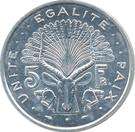 |
5 Francs | Coat of arms of Djibouti | Head of waterbuck ; value | 1991 |
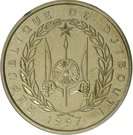 |
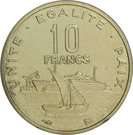 |
10 Francs | Coat of arms of Djibouti | Dhow, Ocean Liner, Port of Djibouti,value | 1997 |
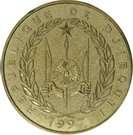 |
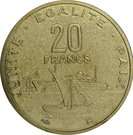 |
20 Francs | Coat of arms of Djibouti | Dhow, Ocean Liner, Port of Djibouti, value | 1997 |
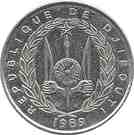 |
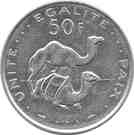 |
50 Francs | Coat of arms of Djibouti | 2 camels | 1989 |
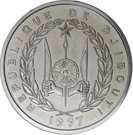 |
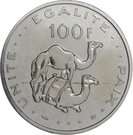 |
100 Francs | Coat of arms of Djibouti | 2 camels | 1997 |
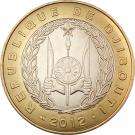 |
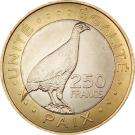 |
250 Francs | Coat of arms of Djibouti | Djibouti spurfowl | 2012 |
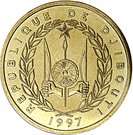 |
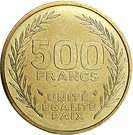 |
500 Francs | Coat of arms of Djibouti | Value | 1997 |
Banknotes
Between 1910 and 1915, banknotes were introduced in denominations of 5, 20 and 100 francs. Chamber of Commerce notes were introduced in 1919 in denominations of 5, 10 and 50 centimes and 1 franc. The decline in the value of the French franc following World War I caused 500 and 1000 franc banknotes to be introduced in 1927 and 1938, respectively. 10 franc notes were introduced in 1946.
When the Public Treasury took over the production of paper money in 1952, the 5, 10 and 20 franc notes ceased production and 5000 franc notes were introduced. In 1970, the 50 and 100 franc notes were replaced by coins. In 1977, the National Bank took over production of banknotes. The only subsequent changes have been the introduction of 10,000 franc notes in 1984 and the replacement of the 500 franc note with a coin in 1989.
| 1979-1988 notes | ||||||
|---|---|---|---|---|---|---|
| Obverse | Reverse | Value | Main Colour | Obverse | Reverse | Date of issue |
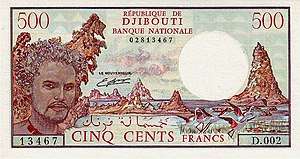 |
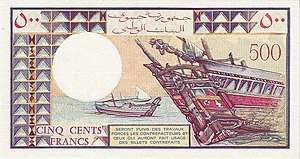 |
500 francs | Multiple colors | Man at left, rocks in sea, storks at right | Stern of ship at right | 1979, 1988 |
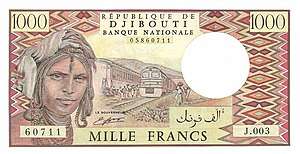 |
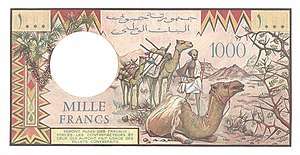 |
1000 francs | Red | Woman at left, people by diesel passenger trains at center | Trader with camels at center | |
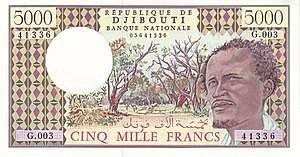 |
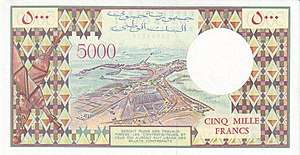 |
5000 francs | Multiple colors | Man at right, forest scene at center | Aerial view | 1979 |
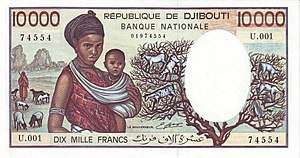 |
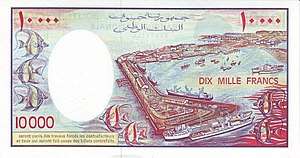 |
10,000 francs | Brown and red | Woman holding baby | Fish and harbor scene | 1984 |
| 1997-2002 notes | ||||||
| Obverse | Reverse | Value | Main Colour | Obverse | Reverse | Date of issue |
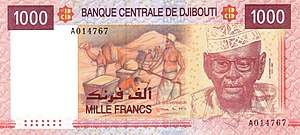 |
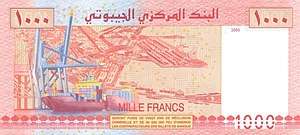 |
1000 francs | Red | Ali Ahmed Oudoum | Port of Djibouti | 2005 |
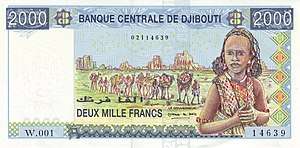 |
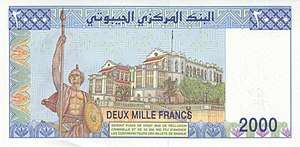 |
2000 francs | Blue | Young girl at right, camel caravan at center | Statue with and shield at lower left, government bldg. at center | 1997 |
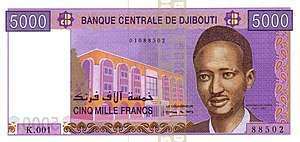 |
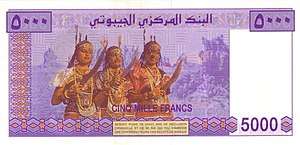 |
5000 francs | Violet | Mahmoud Harbi | Dancers | 2002 |
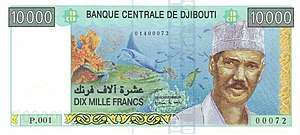 |
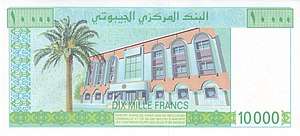 |
10,000 francs | Green | President Hassan Gouled Aptidon | Central Bank building | 1999 |
| 2017 notes | ||||||
| Obverse | Reverse | Value | Main Colour | Obverse | Reverse | Date of issue |
 |
 |
40 francs | Multicolored | Whale Shark, corals | Port of Djibouti | 2017 |
Exchange rate
| Current DJF exchange rates | |
|---|---|
| From Google Finance: | AUD CAD CHF EUR GBP HKD JPY USD |
| From Yahoo! Finance: | AUD CAD CHF EUR GBP HKD JPY USD |
| From XE.com: | AUD CAD CHF EUR GBP HKD JPY USD |
| From OANDA: | AUD CAD CHF EUR GBP HKD JPY USD |
| From fxtop.com: | AUD CAD CHF EUR GBP HKD JPY USD |
Note: Rates obtained from these websites may contradict with pegged rate mentioned above
See also
References
- Krause, Chester L.; Clifford Mishler (1991). Standard Catalog of World Coins: 1801–1991 (18th ed.). Krause Publications. ISBN 0873411501.
- Pick, Albert (1994). Standard Catalog of World Paper Money: General Issues. Colin R. Bruce II and Neil Shafer (editors) (7th ed.). Krause Publications. ISBN 0-87341-207-9.
-5_Francs_(1943).jpg)
